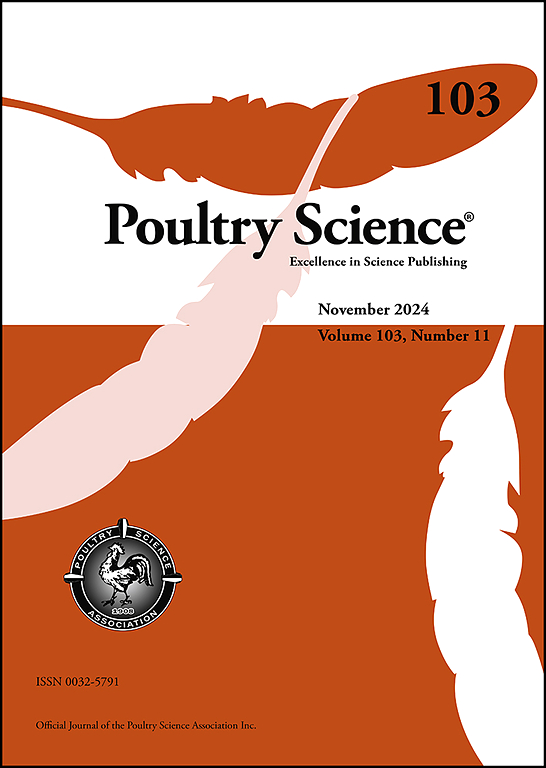遗传品系、饲养密度和日龄对肉鸡行为的影响。
IF 3.8
1区 农林科学
Q1 AGRICULTURE, DAIRY & ANIMAL SCIENCE
引用次数: 0
摘要
肉鸡的快速生长速度和饲养密度是全球关注的动物福利问题。本研究旨在探讨遗传品系和饲养密度对肉鸡行为的影响。在2 × 2随机完全区组设计中,常规(CONV)和慢生长(SG)肉鸡分别以29 kg/m2 (LO, n = 31只/圈)和37 kg/m2 (HI, n = 40只/圈)饲养在16个栏中(n = 4个栏/处理)。在第25天和第39天(对照组和对照组)和第60天(对照组和对照组),通过每天上午和下午的录像观察行为。每个围栏中所有鸟类的百分比(%)分为行走,站立,坐着,侧坐,进食,饮水或梳理。生成两个数据集来比较年龄(25、39d)和市场体重(39d CONV, 60d SG)的影响。在R中拟合线性混合效应模型对数据进行分析。不同品种和年龄的肉鸡坐着行为不同。在第39天,与第25天相比,CONV sat更多(58.3%对54.5%,p < 0.0001),与市场体重的SG相比(58.3%对43.9%,p < 0.0001)。在两个年龄阶段(5.4%比1.4%,p < 0.0001)和市场体重时(7.4%比0.4%,p < 0.0001), CONV肉鸡的侧卧姿势都比SG肉鸡多。SG肉鸡站立和行走行为较多。39日龄和市重时,SG肉鸡行走量大于CONV肉鸡(2.4% vs 1.6, p≤0.01)。此外,SG肉鸡在两个年龄阶段(11.4%比7.2%,p = 0.0004)和市场体重(14.9%比7.1%,p < 0.0001)均高于CONV。虽然在25天的梳理行为没有差异,但SG肉鸡在39天(5.6% vs 3.9%, p < 0.0001)和市场体重(5.5% vs 3.3%, p < 0.0001)时的梳理行为多于CONV肉鸡。低水平饲养的肉鸡在两个年龄阶段的毛率都高于高水平饲养的肉鸡(5.6% vs 5.1%, p = 0.041)。上述结果表明,常规肉鸡表现出更多的坐着行为,而生长缓慢的肉鸡表现出更多的活动行为,在进行比较时应考虑时间和生理年龄的差异。本文章由计算机程序翻译,如有差异,请以英文原文为准。
Effects of genetic strain, stocking density, and age on broiler behavior
Fast growth rate and stocking density are global animal welfare concerns for broiler chickens. The objective of this study was to evaluate the effect of genetic strain and stocking density on the behavior of broilers. In a 2 × 2 randomized complete block design, conventional (CONV) and slow-growing (SG) broilers were stocked at either 29 kg/m2 (LO, n = 31 birds/pen) or 37 kg/m2 (HI, n = 40 birds/pen) in 16 pens (n = 4 pens/treatment). On days 25 and 39 (CONV and SG), and 60 (SG only), behavior was observed from video recorded in the morning and afternoon each day. The percentage (%) of all birds in each pen was categorized as either walking, standing, sitting, lateral sitting, eating, drinking, or preening. Two data sets were generated to compare the effect of age (25, 39d) and market body weight (39d CONV, 60d SG). Linear mixed effects models were fitted in R to analyze data. Sitting behavior differed between broiler strains and ages. At 39d, more CONV sat compared to 25d (58.3 % vs 54.5 %, p < 0.0001) and compared to SG at market weight (58.3 % vs 43.9 %, p < 0.0001). CONV broilers sat in a lateral posture more than SG at both ages (5.4 % vs 1.4 %, p < 0.0001) and at market weight (7.4 % vs 0.4 %, p < 0.0001). Standing and walking behaviors were observed more in SG broilers. SG broilers walked more than CONV at 39d and at market weight (2.4 % vs 1.6, p ≤ 0.01). Further, SG broilers stood more than CONV at both ages (11.4 % vs. 7.2 %, p = 0.0004) and market weight (14.9 % vs. 7.1 %, p < 0.0001). While preening behavior did not differ at 25d, more SG broilers preened than CONV at 39d (5.6 % vs 3.9 %, p < 0.0001) and market weight (5.5 % vs 3.3 %, p < 0.0001). LO-stocked broilers preened more at both ages than at HI (5.6 % vs 5.1 %, p = 0.041). These results suggest that conventional broilers exhibit more sitting behaviors, slow-growing broilers exhibit more active behaviors, and chronological and physiological age differences should be considered when making comparisons.
求助全文
通过发布文献求助,成功后即可免费获取论文全文。
去求助
来源期刊

Poultry Science
农林科学-奶制品与动物科学
CiteScore
7.60
自引率
15.90%
发文量
0
审稿时长
94 days
期刊介绍:
First self-published in 1921, Poultry Science is an internationally renowned monthly journal, known as the authoritative source for a broad range of poultry information and high-caliber research. The journal plays a pivotal role in the dissemination of preeminent poultry-related knowledge across all disciplines. As of January 2020, Poultry Science will become an Open Access journal with no subscription charges, meaning authors who publish here can make their research immediately, permanently, and freely accessible worldwide while retaining copyright to their work. Papers submitted for publication after October 1, 2019 will be published as Open Access papers.
An international journal, Poultry Science publishes original papers, research notes, symposium papers, and reviews of basic science as applied to poultry. This authoritative source of poultry information is consistently ranked by ISI Impact Factor as one of the top 10 agriculture, dairy and animal science journals to deliver high-caliber research. Currently it is the highest-ranked (by Impact Factor and Eigenfactor) journal dedicated to publishing poultry research. Subject areas include breeding, genetics, education, production, management, environment, health, behavior, welfare, immunology, molecular biology, metabolism, nutrition, physiology, reproduction, processing, and products.
 求助内容:
求助内容: 应助结果提醒方式:
应助结果提醒方式:


